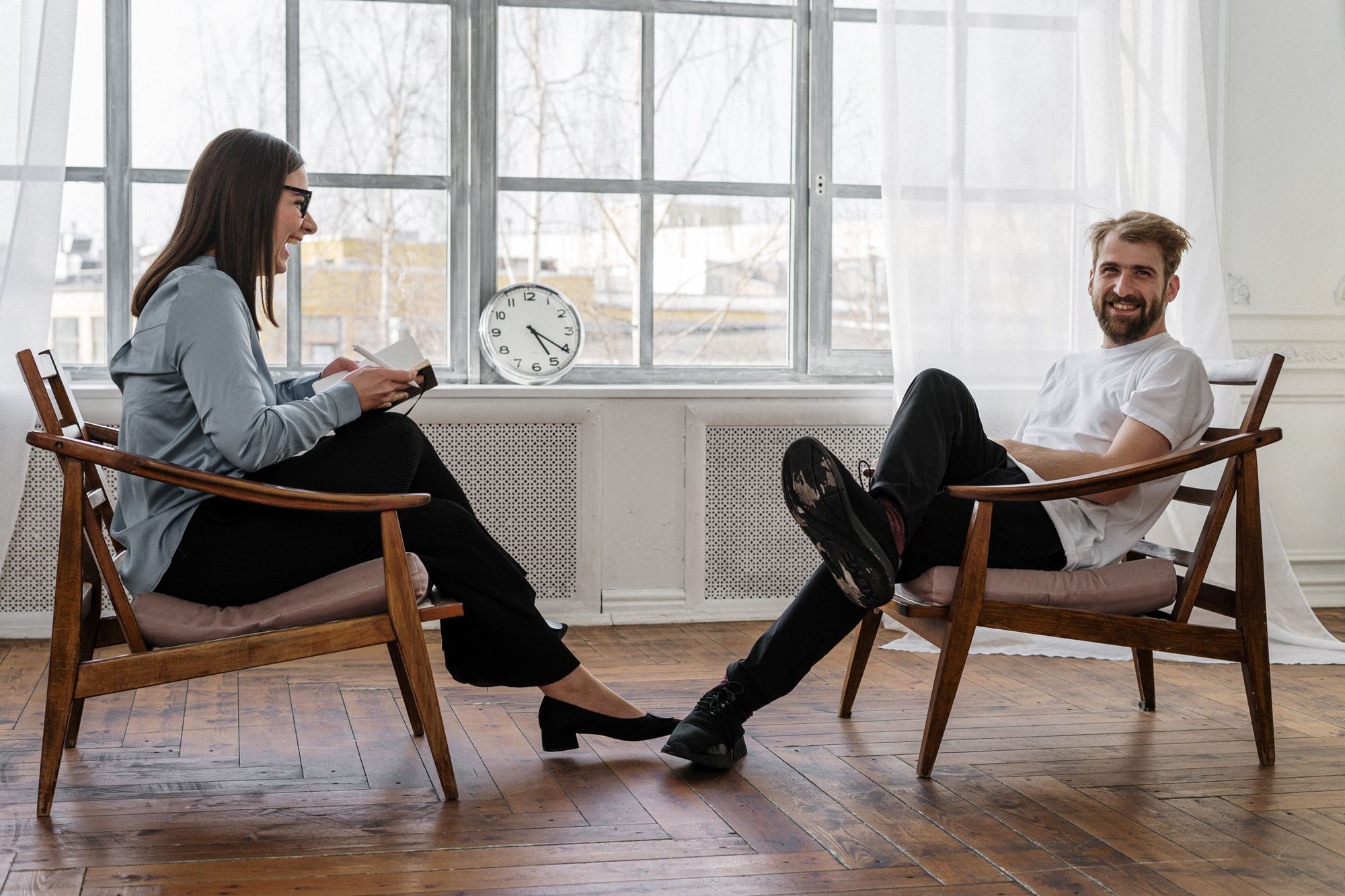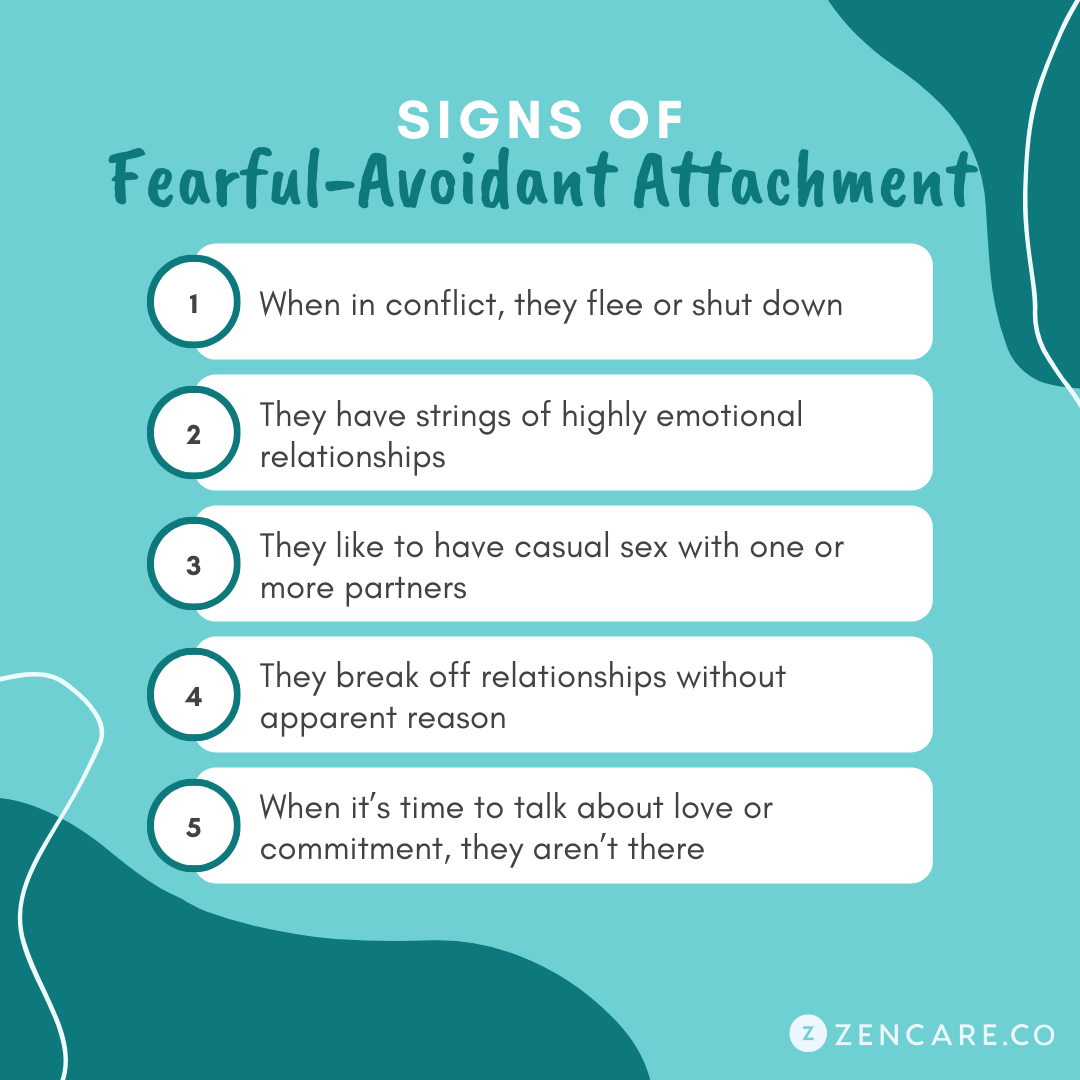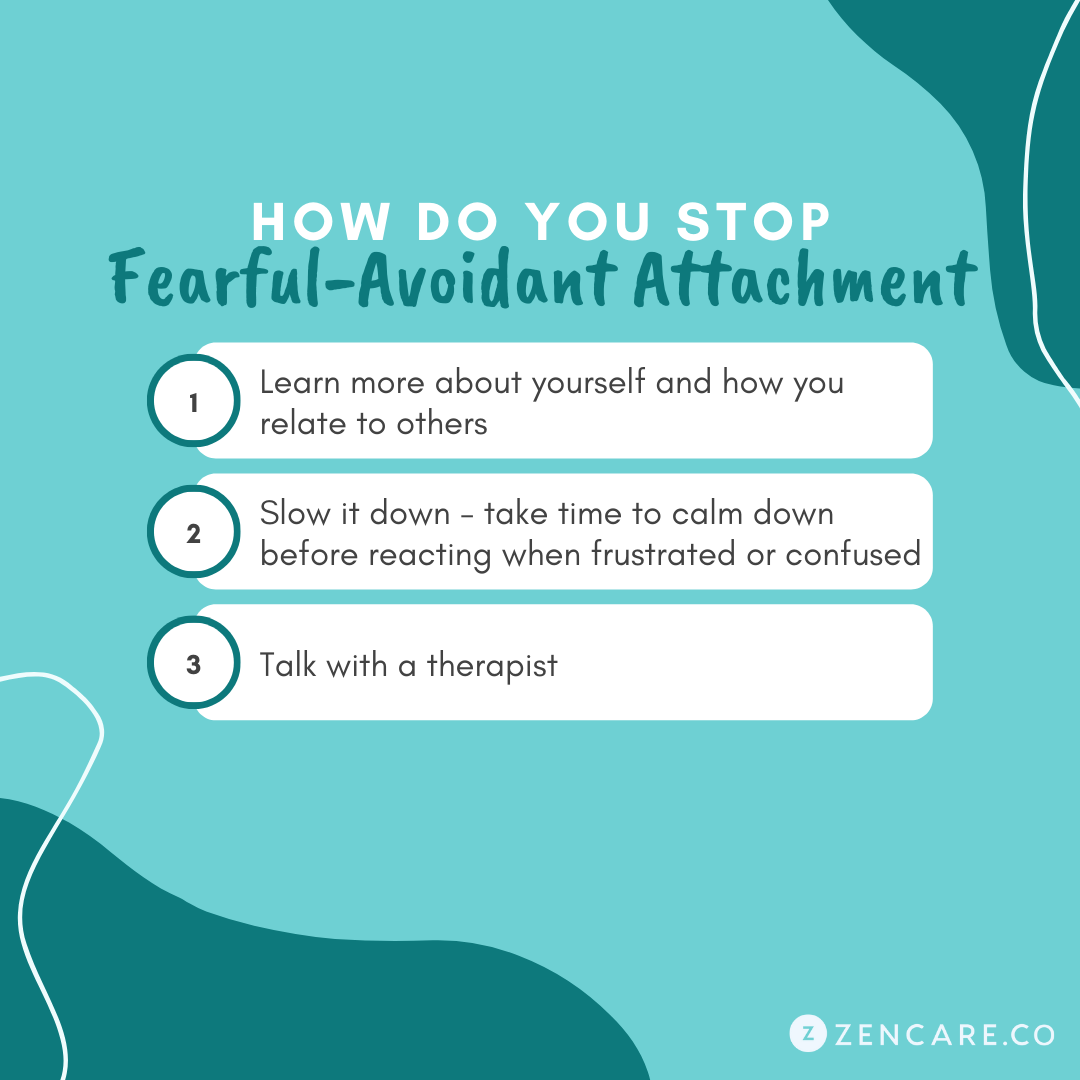So, you took a quiz and found out that your attachment style is fearful avoidant. Or maybe you’ve reflected on past relationships and realized that a pattern of fear and avoidance has kept you from forming meaningful connections. Whether you fear intimacy or avoid commitment, recognizing your attachment style is a critical first step toward healing.
Fearful-avoidant attachment style can be transformed, though it takes practice and self-awareness to revise your patterns. So, what exactly is fearful-avoidant attachment, and how can you address it? Let’s take a closer look.
It’s completely possible to revise your attachment style, though it takes constant practice to learn a new way of connecting with others. The first step, however, is to learn about fearful avoidant attachment style — which is why we’ve answered your questions.

What is a fearful-avoidant attachment style?
Fearful-avoidant attachment, sometimes referred to as disorganized attachment style, is an insecure attachment style. People with this attachment style feel conflicted between wanting emotional closeness in their relationships and being afraid of vulnerability. This creates a push-pull dynamic where someone craves connection but, when intimacy is within reach, they back away out of fear.
In romantic relationships, a person with a fearful-avoidant attachment may long for emotional connection, yet simultaneously avoid committing to deep, intimate relationships. This behavior often leads to emotional rollercoasters in which a person may show strong affection one day but become distant the next, leaving their partner confused. The core issue is the tension between the desire for closeness and a deep-seated fear that relationships will end in pain.
Common Signs of Fearful-Avoidant Attachment
Those with a fearful-avoidant attachment style often exhibit emotional unpredictability. Their relationships may feel chaotic because their needs for connection and fear of vulnerability clash.
Here are common signs you might have this attachment style:
- Avoidance During Conflict: People with fearful-avoidant attachment may avoid conflict at all costs. Instead of addressing issues directly, they may emotionally shut down or physically distance themselves from their partner. This is often a learned behavior from childhood, where emotional expression was met with instability or rejection.
- Intense Emotional Swings: People with this attachment style often feel intense emotional highs and lows in relationships. They might fall in love quickly but struggle to maintain emotional stability when conflicts arise. These shifts often create a turbulent relationship dynamic, marked by both intense closeness and sudden distance.
- Preference for Casual Relationships: People with fearful-avoidant attachment styles may prefer to engage in casual sex or short-term relationships, avoiding the emotional depth that comes with committed, long-term partnerships. The fear of being hurt or abandoned keeps them from fully investing in a serious relationship.
- Sabotaging Relationships: Fearful-avoidant individuals may subconsciously sabotage their own relationships. They may end things abruptly, push away potential partners, or create conflict to avoid the vulnerability of deep emotional intimacy.
- Fear of Commitment: Even if someone with a fearful-avoidant attachment style loves their partner, saying “I love you” or committing to long-term plans may feel terrifying. The fear of abandonment or rejection often outweighs their desire for a serious relationship.
What Causes Fearful-Avoidant Attachment?
According to attachment theory, developed by psychologist John Bowlby, attachment styles form in early childhood. Our experiences with our primary caregiver shape how we relate to others in adulthood. For people with fearful-avoidant attachment, inconsistent caregiving — where caregivers were sometimes nurturing and other times distant or unavailable — contributes to confusion about whether love and support are reliable.
In childhood, we learn how to form bonds through interactions with our caregivers. If a caregiver was emotionally unpredictable or failed to meet the child’s emotional needs consistently, the child may internalize the belief that relationships are unstable. This leads to confusion about emotional intimacy and trust.
Factors That Contribute to Fearful-Avoidant Attachment:
- Inconsistent Care: If a caregiver was present and loving one moment but withdrawn or unresponsive the next, a child might develop conflicting feelings about relationships. This inconsistency leads to anxiety in relationships as an adult, as they expect relationships to be unreliable or unpredictable.
- Early Childhood Trauma: Unresolved trauma, such as emotional neglect, abandonment, or witnessing family conflict, can deeply impact how a child develops attachments. These traumatic experiences leave lasting impressions that influence how they navigate emotional closeness as adults.
- Low Self-Esteem and Fear of Abandonment: Many people with fearful-avoidant attachment struggle with low self-esteem. They may feel unworthy of love, leading them to question whether their partners will abandon them. This often results in a fear of abandonment, where they push others away to protect themselves from anticipated rejection.
- Lack of Emotional Security: Insecure attachment styles, including fearful-avoidant attachment, arise when children don’t feel safe expressing their emotions. If a child’s needs were dismissed or met with criticism, they may grow up fearing emotional expression and connection.

The Impact of Fearful-Avoidant Attachment on Adult Relationships
Fearful-avoidant attachment significantly affects adult relationships, particularly romantic ones. Because people with this attachment style struggle with trust and emotional intimacy, they often have difficulty forming secure, long-term relationships.
In romantic relationships, this attachment style manifests as a cycle of emotional push-pull. People with fearful-avoidant attachment may fall deeply in love but then sabotage the relationship by withdrawing when things get serious. This creates a confusing dynamic for their partners, who may feel unsure about where they stand.
- Romantic Partners: Fearful-avoidant individuals often find it challenging to express their true emotions to romantic partners. They may long for closeness but fear that revealing their vulnerabilities will lead to rejection. This makes building emotional intimacy difficult, often resulting in emotionally distant or volatile relationships.
- Sexual Partners: Some fearful-avoidant individuals may opt for casual relationships or multiple sexual partners as a way of avoiding emotional commitment. Casual encounters provide physical closeness without the emotional risk of deep connection.
- Family Relationships: Family dynamics can be strained when someone with a fearful-avoidant attachment style struggles to open up emotionally. They may maintain a surface-level relationship with family members while avoiding emotional conversations that require vulnerability.

Healing from Fearful-Avoidant Attachment: How to Make Positive Change
Although fearful-avoidant attachment can feel overwhelming, it is possible to heal and develop healthier ways of relating to others. With awareness and intentional effort, you can shift your attachment style toward one that fosters secure, stable relationships.
Here are some key steps to begin healing:
1. Gain Insight into Your Attachment Style
The first step toward healing is understanding your attachment patterns. Reflect on your past relationships, both romantic and platonic, to identify instances where fear or avoidance led you to distance yourself emotionally. You might notice that childhood experiences or unresolved trauma still affect your behavior in adult relationships.
Journaling or talking with a trusted friend about your feelings and past relationships can help you gain clarity. This self-awareness is the foundation for change, allowing you to recognize and address your emotional triggers.
2. Seek Professional Help
Therapy is one of the best ways to address fearful-avoidant attachment. A therapist trained in attachment theory can help you explore how your childhood experiences and attachment patterns affect your relationships today. By working through these issues with a therapist, you can develop healthier ways of relating to others.
Trauma-informed care is particularly helpful for people with fearful-avoidant attachment. Therapists who practice trauma-informed care understand how past traumatic experiences shape current behaviors and emotional responses. They can help you build a sense of security in your relationships and work through unresolved trauma.
3. Practice Emotional Regulation
People with fearful-avoidant attachment often experience intense emotions that can feel overwhelming. Learning to regulate these emotions is crucial for building healthier relationships. Techniques like deep breathing, mindfulness, and taking breaks during heated arguments can help you manage emotional stress more effectively.
By calming your body and mind before reacting to emotional triggers, you create space for more thoughtful responses in your relationships. This can prevent emotional outbursts or the urge to withdraw when you feel vulnerable.
4. Build Trust Slowly
Trust is a major issue for people with fearful-avoidant attachment. To build trust in your relationships, it’s important to take small steps toward emotional openness. Start by sharing your thoughts and feelings with someone you trust. As you see that your vulnerability is met with support rather than rejection, you’ll begin to feel more secure.
Building healthy boundaries in relationships is also important. This helps create a safe space where both you and your partner feel comfortable expressing your needs and emotions.
5. Challenge Negative Beliefs
Many fearful-avoidant individuals have a negative view of themselves and their relationships. They may believe they are unworthy of love or that their relationships are doomed to fail. These beliefs can be deeply ingrained but are not based on reality. Therapy can help you identify and challenge these negative thoughts, replacing them with more positive, realistic beliefs.
When you notice yourself thinking negatively about your relationships or self-worth, pause and question the validity of those thoughts. Reframing your mindset toward a more positive outlook can significantly improve your emotional well-being.
6. Work on Building Emotional Intimacy
Fearful-avoidant individuals often struggle with emotional intimacy, fearing that opening up too much could lead to rejection or abandonment. But building intimacy is critical to forming healthy, meaningful relationships. Start small by sharing aspects of your life, feelings, and thoughts that you might usually hold back from others. With close relationships, particularly romantic ones, try discussing your fears and anxieties in a gentle and open way.
It can be especially beneficial to talk with your partner or trusted loved ones about your attachment style. Sharing what you’ve learned about fearful-avoidant attachment not only creates understanding but also builds a stronger foundation for emotional closeness. Your loved ones may not realize why you react a certain way, and having that open communication is essential for creating a safe space where vulnerability is welcomed.
7. Develop a Stronger Sense of Self
People with fearful-avoidant attachment often struggle with low self-esteem, which impacts their ability to form secure relationships. A key part of healing involves cultivating a strong sense of self — developing confidence in who you are, independent of your relationships. When you don’t base your self-worth entirely on your connections with others, it becomes easier to engage in healthy boundaries and trust that you’re worthy of love and respect.
One way to build self-esteem is through self-compassion. Many people with fearful-avoidant attachment are highly critical of themselves, believing they’re unlovable or broken because of their emotional struggles. By practicing self-compassion — reminding yourself that everyone has fears, doubts, and insecurities — you can start to heal the negative self-perception that holds you back.
8. Understand Your Emotional Triggers
One of the most helpful steps in healing from a fearful-avoidant attachment style is learning to identify and manage your emotional triggers. Emotional triggers are specific situations or events that bring up intense feelings of fear, abandonment, or rejection. For someone with this attachment style, triggers might include perceived criticism, a partner’s withdrawal, or discussions about long-term commitment.
Start paying attention to what triggers these intense feelings of fear or avoidance in your relationships. Once you identify the trigger, you can begin to separate your emotional reaction from the event itself. For instance, if you feel panicked when your partner wants to discuss the future, it could be helpful to ask yourself if your fear is rooted in the current reality of your relationship or in past experiences of abandonment or rejection.
Moving Toward Secure Relationships
Healing from fearful-avoidant attachment takes time, but the effort is worth it. By gaining insight into your emotional patterns, seeking therapy, and practicing emotional regulation, you can shift toward a more secure attachment style. The process may involve discomfort and vulnerability, but it leads to stronger, healthier relationships built on trust and emotional closeness.
If you’re ready to take the next step, finding a therapist who specializes in attachment styles can be transformative. A therapist can help you work through your fears, challenge negative beliefs, and develop healthier relationship habits. With the right support, you can create lasting change and build secure bonds with the people who matter most in your life.
Remember, the most important factor in your therapy success is to find a therapist with whom you connect — this is especially essential when you want to work on how you connect with others! By reading each therapist’s professional statement and watching their introductory video, you’ll find an amazing therapist that is just right for you.